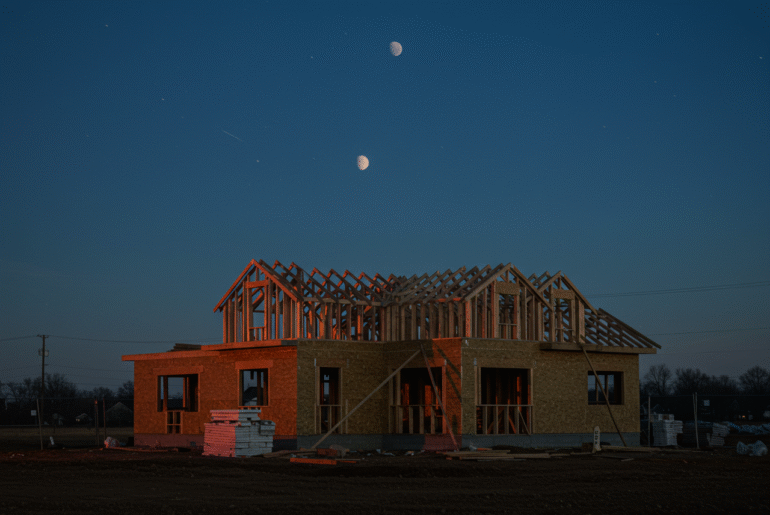This article may contain references to products or services from one or more of our advertisers or partners. We may receive compensation when you click on links to those products or services. Nonetheless, our opinions are our own.
The information presented in this article is accurate to the best of our knowledge at the time of publication. However, information is subject to change, and no guarantees are made about the continued accuracy or completeness of this content after its publication date.
- Introduction
- Home Construction Timeline by Phase
- Breakdown of Construction Phases
- Factors That Influence Build Time
- Timelines for Different Home Types
- Tips to Stay on Schedule
- Sample Construction Milestone Timeline
- Financial Impact of Delays
- Permits, Site Conditions, and Location
- Regional Construction Timelines in the U.S.
- Preparing for Move -In
- Frequently Asked Questions
- Design Factors That Affect Timeline
- Move-In Timing for Spec vs. Custom Homes
- Summary of Home Construction Timelines
- Recommended Reads
Introduction
Building your dream home is a major milestone that involves many moving parts. A common question that arises is: How long does it take to build a house? The answer depends on several variables, from home type and design complexity to weather and permits. Factors such as zoning laws, labor availability, and material sourcing also contribute to the overall timeline. Homeowners should be aware that while there is an average timeline, individual projects can vary widely. This breakdown covers each phase of home construction, outlines typical build times by home type, and offers tips to help you stay on track financially and logistically. Whether you’re considering a custom build or a quick spec home purchase, understanding each stage can help you plan more confidently.
Home Construction Timeline by Phase
The construction process is typically divided into the following phases. Each plays a critical role in the overall duration and success of your home-building journey. Understanding the function and time frame of each stage helps you plan accordingly and anticipate potential delays.
| Phase | Typical Duration | Description |
|---|---|---|
| Pre-Construction | 1–3 months | Financing, design finalization, and permits |
| Site Preparation | 2–4 weeks | Land clearing, grading, layout marking |
| Foundation & Framing | 1–3 months | Pouring the foundation and framing walls/roof |
| MEP (Mechanical, Electrical, Plumbing) | 1–2 months | Installation of HVAC, plumbing, and wiring |
| Interior & Exterior Finishes | 2–4 months | Painting, flooring, cabinetry, siding, roofing |
| Final Inspection & Handover | 1 month | Local authority inspection and occupancy certificate |
Breakdown of Construction Phases
Design and Planning
This early phase includes budgeting, selecting the home design, and reviewing zoning and code requirements. Choosing the right builder and finalizing contracts also occur here, setting the foundation for a smooth construction experience.
Site Preparation and Foundation
During this phase, land is cleared of trees and debris, leveled for proper drainage, and surveyed. Based on the home design, a slab, crawlspace, or basement foundation is poured and inspected to ensure structural stability.
Framing
The home’s skeleton begins to take shape during framing. This includes erecting walls, installing roof trusses, and adding windows and doors. Once complete, the house becomes weather-tight, allowing work to proceed indoors.
Mechanical, Electrical, and Plumbing
Major systems such as HVAC, plumbing pipes, and electrical wiring are installed in this stage. Inspections are typically required after installation to ensure safety and code compliance before walls are sealed.
Interior and Exterior Finishes
This is where the home’s aesthetic features come to life. Builders install drywall, cabinetry, flooring, fixtures, siding, and roofing. Paint, trim, and lighting give the house its finished look and feel.
Final Inspection and Occupancy
The home undergoes a final walkthrough by both the builder and local authorities to ensure compliance with safety and building codes. Once approved, a Certificate of Occupancy is issued, and the house is ready for move-in.
Factors That Influence Build Time
| Factor | Impact on Timeline |
|---|---|
| Home size and complexity | Larger or custom homes require more materials and labor, often leading to extended timelines. |
| Weather conditions | Inclement weather can halt outdoor work, especially during foundation and roofing phases. |
| Permit approvals | Permitting delays vary by location and can stall the start of construction for weeks or months. |
| Supply chain issues | Material shortages or delayed deliveries can push back scheduled tasks and inspections. |
| Contractor availability | High demand during peak seasons may lead to scheduling conflicts and slower project progress. |
Timelines for Different Home Types
| Home Type | Typical Timeline | Details |
|---|---|---|
| Custom Homes | 10–18 months | Fully personalized homes require more time for planning, materials, and changes during construction. |
| Semi-Custom Homes | 6–12 months | These use pre-designed layouts with room for modifications, offering flexibility with reduced timelines. |
| Spec Homes | 0–3 months | Already built or near completion, these homes are ideal for quick move-ins with limited design input. |
| Tract Homes | 4–9 months | Produced on a large scale using standardized plans, these are quicker to build due to efficiency and repetition. |
| Townhomes/Condos | 6–10 months | Build time varies depending on unit size, number of floors, and construction phase overlaps. |
| Renovated Homes | 3–9 months | Renovations may be faster but often face delays from unforeseen structural or permit issues. |
Tips to Stay on Schedule
Secure Financing Early
Getting pre-approved helps streamline the pre-construction phase and avoids financial delays during key milestones.
Review Contracts Thoroughly
Understanding the scope, build timeline, and penalty clauses can help you avoid misunderstandings and future setbacks.
Minimize Change Orders
Changing materials, finishes, or layouts after construction starts can cause delays and add unexpected costs.
Communicate Often
Regular check-ins with your builder help address concerns early and keep the project moving according to plan.
Account for Permits and Inspections
Be prepared for gaps in the timeline as you wait for necessary approvals and safety inspections at each stage.
Factor in Weather and Seasons
Try to schedule critical exterior work during mild weather months to reduce weather-related construction pauses.
Voted "Best Overall Budgeting App" by Forbes and WSJ
Monarch Money helps you budget, track spending, set goals, and plan your financial future—all in one app.
Get 50% OFF your first year with code MONARCHVIP
Sample Construction Milestone Timeline
| Milestone | Estimated Duration |
|---|---|
| Groundbreaking & Footings | Weeks 1–2 |
| Foundation & Framing | Weeks 3–10 |
| MEP Installation | Weeks 11–16 |
| Finishes & Exterior Work | Weeks 17–28 |
| Final Inspection & Move-In | Weeks 29–32 |
Financial Impact of Delays
| Delay Type | Cost Implication |
|---|---|
| Labor overruns | Prolonged schedules result in extra payments to contractors or specialists working by the hour or day. |
| Material price changes | Delays can cause material prices to increase due to inflation or reduced availability. |
| Interest accrual | Extended timelines increase loan interest, raising the overall financing cost of your project. |
Permits, Site Conditions, and Location
Permits can take weeks to months depending on zoning laws, environmental concerns, and the responsiveness of local authorities. Homeowners must prepare for potential wait times and resubmissions. Site conditions like steep slopes, poor soil, or lack of nearby utilities can also extend the prep phase. Additionally, your region may be subject to building seasonality due to weather, which can delay groundwork and inspections. Zoning regulations and code requirements vary by municipality and should be reviewed early in the planning stage.
Regional Construction Timelines in the U.S.
| Region | Typical Duration |
|---|---|
| Northeast | 9–14 months |
| Midwest | 7–12 months |
| West | 6–11 months |
| South | 6–10 months |
Preparing for Move -In
Before moving into your new home, it’s important to complete several key steps to ensure a smooth transition. Set up all utilities electricity, gas, water, and internet well in advance to avoid service interruptions. Schedule your final walkthrough to identify any lingering issues that need resolution. Booking movers early helps lock in availability and reduces last-minute stress. You should also pre-plan your furniture layout and prioritize essentials so your home feels functional right away after move-in.
Sample Move-In Timeline
| Task | When to Do It |
|---|---|
| Final inspection | 4–6 weeks before |
| Utilities setup | 2–3 weeks before |
| Hire movers | 2 weeks before |
| Walkthrough | 1 week before |
| Unpack | After move-in |
Frequently Asked Questions
What are the main phases of home construction?
The main phases include planning, permitting, site preparation, foundation work, framing, mechanical and electrical installation, interior and exterior finishes, and final inspection before move-in. Each stage plays a crucial role in building a safe and livable home.
How long does it take to build a house?
On average, it takes between 6 and 12 months to build a house. This varies based on the type of home, location, complexity of design, and weather conditions. Delays or fast-tracking can shift this estimate significantly.
What can delay construction?
Several issues can delay construction, such as permit problems, bad weather, supply shortages, labor unavailability, and change orders during the build. Some delays are unavoidable, while others can be mitigated with proper planning.
Can I speed up the process?
Yes. Choosing pre-approved plans, reducing custom changes, securing financing early, and hiring an experienced builder can all help reduce delays. Regular communication and timely decisions are also essential to keep construction on track.
How can I track construction progress?
You can use spreadsheets, mobile apps, or regular meetings with your builder to track the construction timeline. Progress photos, milestone checklists, and site visits provide added visibility and control over your project.
What’s the average U.S. build time?
The average time to complete a home in the U.S. is about 6 to 12 months, according to the U.S. Census Bureau. The timeline may vary based on region, build type, and builder efficiency.
What’s your top tip for first-time builders?
Expect delays and budget for a 10–15% cushion. Stay in constant communication with your contractor and document everything. Clear expectations and regular follow-up will reduce misunderstandings and cost overruns.
Design Factors That Affect Timeline
- Square footage and layout
- Number of bedrooms and bathrooms
- Number of stories
- Garage size
- Structural complexity
- Plan width and depth
Move-In Timing for Spec vs. Custom Homes
It is possible to move in immediately, but this usually applies to spec homes that are already built or nearing completion. Custom homes and new builds require final inspections and official occupancy certificates before move-in is allowed. Buyers should ensure all punch list items are completed and local codes are satisfied before scheduling move-in.
Summary of Home Construction Timelines
Building a house takes careful planning, reliable financing, and coordination with experienced professionals. While the timeline ranges from a few months to over a year depending on the home type and region, awareness of each construction phase and potential delay can help you stay on schedule. Permits, inspections, supply delays, and labor availability all play a role. Proactive planning, budget buffers, and ongoing communication can prevent small issues from becoming major roadblocks. With the right preparation, your home-building journey can be smooth and rewarding. Take the time to understand each step, and you’ll enjoy the process and the finished result even more.

Reviewed and edited by Albert Fang.
See a typo or want to suggest an edit/revision to the content? Use the contact us form to provide feedback.
At FangWallet, we value editorial integrity and open collaboration in curating quality content for readers to enjoy. Much appreciated for the assist.
Did you like our article and find it insightful? We encourage sharing the article link with family and friends to benefit as well - better yet, sharing on social media. Thank you for the support! 🍉
Article Title: How Long Does It Take to Build a House? Timeline by Phase and Home Type
https://fangwallet.com/2025/08/01/how-long-does-it-take-to-build-a-house-timeline-by-phase-and-home-type/The FangWallet Promise
FangWallet is an editorially independent resource - founded on breaking down challenging financial concepts for anyone to understand since 2014. While we adhere to editorial integrity, note that this post may contain references to products from our partners.
The FangWallet promise is always to have your best interest in mind and be transparent and honest about the financial picture.
Become an Insider

Subscribe to get a free daily budget planner printable to help get your money on track!
Make passive money the right way. No spam.
Editorial Disclaimer: The editorial content on this page is not provided by any of the companies mentioned. The opinions expressed here are the author's alone.
The content of this website is for informational purposes only and does not represent investment advice, or an offer or solicitation to buy or sell any security, investment, or product. Investors are encouraged to do their own due diligence, and, if necessary, consult professional advising before making any investment decisions. Investing involves a high degree of risk, and financial losses may occur including the potential loss of principal.
Source Citation References:
+ Inspo
There are no additional citations or references to note for this article at this time.












































